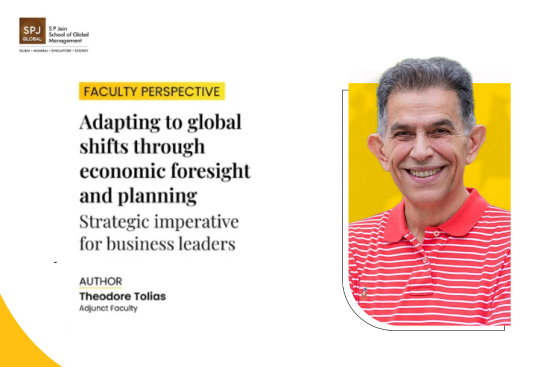
In a world defined by geopolitical tension, shifting trade alliances, accelerating technological disruption, and growing state intervention, business leaders are increasingly called upon to interpret and respond to forces beyond their immediate control.
In a world defined by geopolitical tension, shifting trade alliances, accelerating technological disruption, and growing state intervention, business leaders are increasingly called upon to interpret and respond to forces beyond their immediate control.
Adapting to Global Shifts Through Economic Foresight and Planning: A Strategic Imperative for Business Leaders
Economics, as traditionally taught, is no longer sufficient. The global business environment is now much less governed by simple supply and demand dynamics. Strategic rivalry, regulatory power, protectionist impulses, and the reassertion of government influence in markets are becoming ever more important. At the same time, economic inequality, within and across nations, is shaping both the political climate and the economic tools used in response. For Executive MBA (EMBA) students and senior decision-makers alike, Business Economics provides the tools to navigate this complexity and connect external economic shifts directly to critical business decisions.

Geoeconomics
One of the most important evolutions in executive thinking today is the ability to see how economics, politics, and strategy are intertwined. Geoeconomics—the use of economic instruments for geopolitical purposes—is now both a dominant aspect of reality and an important emerging paradigm in the field of Economics. China’s Belt and Road Initiative and the U.S. pressure on EU countries to block Huawei’s 5G technology on national security grounds are classic examples of geoeconomics in action. Trade policies are no longer designed solely to promote efficiency; they are deployed as tools of national advantage. Tariffs, investment restrictions, and industrial subsidies are frequently shaped less by market logic than by power politics with significant consequences. Business leaders must therefore interpret not only market signals but also the strategic intentions of states and their consequences on economic opportunity and welfare. For instance, when China imposes export controls on rare earths, or when Canada extends subsidies to attract electric vehicle manufacturers, these actions are not just abstract policy decisions—they are direct inputs into business planning, cost structures, and long-term competitive positioning, often with wider implications for who gains and who is left behind in the new industrial order.
The Return of Protectionism and Rent-Seeking
This blurring of economics and statecraft demands a deeper understanding of how protectionism and trade barriers influence global value chains. The return of tariffs and trade restrictions means that cross-border business is no longer simply about identifying the lowest cost or highest growth location. Instead, executives must consider regulatory risk, diplomatic relations, and the potential for sudden policy reversals. A tariff introduced overnight can erase margin assumptions, disrupt sourcing, or stall market entry plans. Beyond the mechanics of cost, the political economy underlying these changes—including lobbying pressures, rent-seeking behaviour, and populist trade narratives—must be considered to anticipate how and why such policies emerge.
These developments also demand an appreciation of rent-seeking—the tendency of industries to lobby for favourable treatment in the form of tariffs, subsidies, or regulations that benefit the few at the expense of broader market efficiency. As governments become more involved in directing economic outcomes, the likelihood of distorted incentives increases. Firms that can navigate this complexity by aligning with national priorities or hedging against policy reversals will enjoy a strategic advantage.
Tech Monopolies, Regulation, and Innovation Policy
Nowhere is the intersection of markets and public policy more visible than in regulating digital technologies. Governments are no longer standing by as passive observers of tech giants; they are actively regulating data use, privacy standards, platform power, and algorithmic transparency. These measures reflect a growing recognition of market failures in the digital economy, particularly around monopoly power, data asymmetry, and the unequal distribution of both opportunity and harm in technological progress. For firms operating in or adjacent to the tech sector, regulatory uncertainty is now a strategic variable, affecting everything from product design to global expansion.
At the same time, the state is emerging not only as a regulator but also as an active economic agent through industrial policy. Governments are investing directly in areas they deem strategically vital, including artificial intelligence, semiconductors, clean energy, and advanced manufacturing. These interventions, however, often raise questions: Who benefits from subsidies and public investment? Whose regions or communities are left out? Understanding how policy frameworks are constructed—who benefits, who pays, and what risks are baked into the system—allows leaders to identify opportunities for alignment and avoid costly missteps.
Stabilisation Policy, Inequality, and Business Confidence
Macroeconomic stabilisation—through monetary and fiscal policy—has once again taken centre stage. After years of ultra-low interest rates, central banks around the world have pivoted toward tightening in response to persistent inflation. These moves have immediate implications for corporate borrowing, consumer demand, currency volatility, and investment flows. Now more than ever, business leaders must incorporate central bank signals, fiscal stimulus patterns, credit ratings, and market sentiment into operational and strategic decisions.
However, it is equally important to understand the distributional effects of these macro policies. Higher interest rates may stabilise inflation, but they also increase the burden on lower-income households, depress real wages, and widen wealth gaps by disproportionately affecting the most vulnerable. Inflation, too, does not strike evenly, eroding the purchasing power of those with fewer assets while leaving wealthier households better insulated. Fiscal policy, whether in the form of targeted stimulus, infrastructure investment, or industrial subsidies, can either cushion or exacerbate volatility depending on how resources are allocated. An economically literate leadership team is better equipped to interpret these signals, weigh the trade-offs, and act proactively rather than reactively.
Strategic Rivalry, Scenarios, and Decision-Making Under Uncertainty
To respond effectively to global shifts, executives must embrace a mode of thinking grounded in uncertainty and interdependence. Business Economics trains leaders to construct plausible scenarios not as predictions, but as tools for resilience and stress testing. The intersection of strategic rivalry, regulatory flux, and disruptive technologies means that the future will not unfold in a straight line. Instead, leaders must prepare for diverging paths, whether that is a multipolar world defined by regional blocs, a green industrial surge driven by climate commitments, or a techlash environment where innovation is constrained by regulation, to name a few.
In each scenario, economic foresight offers the lens to understand what might trigger change and how it might propagate across sectors, geographies, and supply chains. Again, the goal is not perfect foresight, but agility and stress testing: the ability to recognise early warning signs, test assumptions, and adjust course with confidence. This is where the study of both market and government failure becomes critical. Leaders must recognise when markets are misallocating resources, as well as when policy interventions deepen inequality or ignore social outcomes. Only by understanding both sides of the equation can firms position themselves effectively and sustainably.
Bottom Line: The Value of Business Economics
For business leaders and EMBA students at SP Jain Global, the value of Business Economics lies in its relevance. It equips leaders to ask better questions: How will new trade rules affect our sourcing strategy? Will a tighter monetary policy weaken demand in our key markets? What risks emerge from depending on a subsidised competitor? And where are the public-private partnerships that might unlock growth, and for whom?
This mindset—linking external economic changes to internal business levers—is essential in today’s business environment. It enables smarter pricing, more flexible investment, better risk management, and stronger stakeholder engagement. Perhaps most importantly, it fosters a leadership culture that is alert, informed, and proactive in the face of systemic change. It also encourages a broader awareness of equity and inclusion, not only as ethical imperatives but as strategic considerations in a world where inequality increasingly drives both policy and public sentiment.
The world is not getting simpler. But leaders who can embrace complexity, understand context, interpret economic signals, anticipate policy shifts, and navigate the interplay of markets, governments, and communities stand a much better chance of success.
About the Author
Theodore Toilas, Adjunct Faculty at SP Jain Global, brings decades of expertise in economics and global business, teaching EMBA courses such as Managerial Economics and Global Business Environment. Holding degrees from the University of Toronto and Aristotle University, he also mentors student projects in business and macroeconomic analysis.
Enjoyed this article? Read more expert perspectives and insights from our faculty here.










